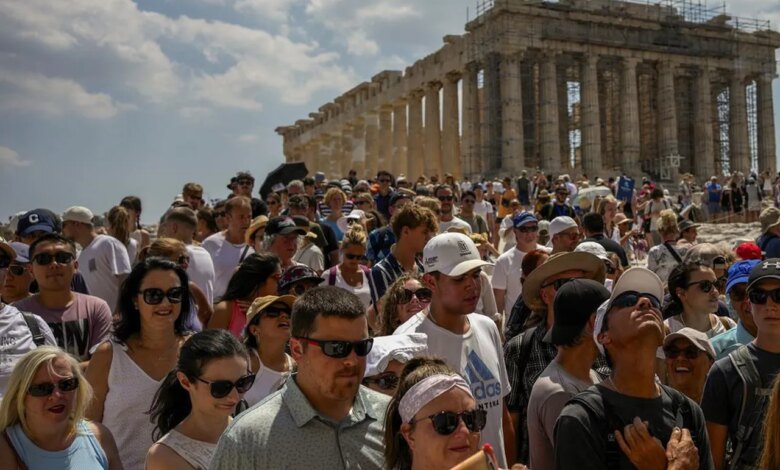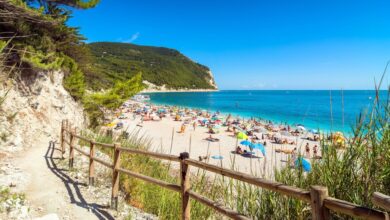Tourists pack European hotspots. And Americans don’t mind the higher prices and crowds

VENICE, Italy (AP) — Tourists wait more than two hours to visit the Acropolis in Athens. The taxi lines at Rome’s main train station are just as long. And so many visitors concentrate around St. Mark’s Square in Venice that crowds pile up when crossing bridges – even on weekdays.
After three years of pandemic restrictions, tourism is expected to surpass 2019 records in some of Europe’s most popular destinations this summer, from Barcelona and Rome, Athens and Venice to the scenic islands of Santorini in Greece, Capri in Italy and Mallorca in Spain.
While European tourists pushed the industry to recovery last year, the uptick this summer has largely led by Americansstimulated by one strong dollar and in some cases, pandemic savings. Many arrive motivated by “revenge tourism” – so eager to re-explore that they’re undeterred by higher airfare and hotel costs.
Lauren Gonzalez, 25, landed in Rome this week with four high school and college friends for a 16-day romp through the Italian capital, Florence and the coast after three years of US vacations. They are not worried about the high prices and the crowds.
“We saved a little bit and we know this is a meaningful journey,” says Gonzalez, who works at a marketing agency. “We are all in our mid-twenties. It is a (moment of) change in our lives. … This is something special. The crowds don’t scare us. We live in Florida. We’ve all been to Disney World in the heat. We’re all good.”
Americans appear right away unperturbed by the recent riots in Paris and other French cities. There was a small drop in flight bookings, but that was mainly for domestic travel.
“Some of my friends said, ‘It’s kind of crazy in there right now,’ but we thought summer is a really good time for us to go, so we’ll just take precautions,” Joanne Titus, a 38-year-old from Maryland, said while walking down the iconic shopping boulevard Champs-Elysees.
The return of mass tourism is a boon for hotels and restaurants, which have suffered from COVID-19 restrictions. But there is also a downside, viz promises to rethink tourism to make it more sustainable have been largely ignored.
“The pandemic should have taught us a lesson,” said Alessandra Priante, director of the regional division for Europe at the UN World Tourism Organization.
Instead, she said, the mindset is “about getting the money back. Everything revolves around turnover, about the here and now.”
“We have to see what will happen in two or three years, because prices are unsustainable at the moment,” she said.
The mayor of Florence is stopping new short-term rental of apartments of sprawl in the historic center, which is protected as a UNESCO World Heritage Site, while mayors of Italy’s other cities of art are calling for a nationwide law to manage the sector.
Elsewhere, the anti-mass tourism movements active before the pandemic have failed to return, but the battle lines are still being drawn: graffiti in Barcelona wrongly directed tourists away from – rather than towards – the Gaudi-designed Park Güell.
Despite predictable areas of overtourism, overall travel to and within Europe is still down 10% from 2019, according to the World Tourism Organization. That’s partly because fewer people are visiting nearby countries war in Ukraineincluding Lithuania, Finland, Moldova and Poland.
In addition, Chinese visitors have not fully returned, with flights from China and other Asia-Pacific countries down 45% from 2019, according to travel data company ForwardKeys.
Tourism-dependent Greece expects 30 million visitors this year, still short of the record 34 million set in 2019. Still, flights have soared so far and tourist hotspots are taking the brunt.
The Ministry of Culture is introducing a new ticketing system for the Acropolis this month, giving visitors hourly slots to even out the crowds. But no solution is being discussed for cruise ship parking queues on the islands of Mykonos and Santorini on busy mornings.
Spain’s tourism minister, Héctor Gómez, called it “a historic summer for tourism”, with 8.2 million tourists arriving in May alone, a record for the second month in a row. Still, some hotel groups say reservations have slowed in the first weeks of summer due to the surge in flight and room prices.
According to ForwardKeys, costs are rising as flights from the US to Europe are up 2% from 2019.
“The increasing interest in long-haul travel from America is the continued result of the ‘revenge travel’ boom resulting from the pandemic lockdowns,” said Tim Hentschel, CEO of HotelPlanner, a booking site. “Large cities in these popular European countries will certainly be busy in the summer.”
Americans have seen arrivals at Italian bucket-list destinations like Rome, Florence, Venice and Capri above pre-pandemic levels, according to the Italian hotel association Federalberghi.
They bring a lot of pent-up spending power: American tourists in Italy spent 74% more on tax-free indulgences in the first three months of the year than in the same period of 2019.
“Then there is the rest of Italy that lives off Italian and European tourism, and at the moment it is still below 2019 levels,” said Federal Berghi president Bernabo Bocca.
He expects it will take another year for a general recovery. An economic slowdown discouraged German arrivals, while Italians are “less likely to spend this year,” he said.
And wallets are stretched. According to Italian consumer group Codacons, accommodation costs in Florence rose 53% from last year, while Venice saw a 25% increase and Rome a 21% increase.
Even gelato costs 21% more than last year, because of higher sugar and milk prices.
Perhaps nothing has encouraged the boom in tourism in key places more than an increase in short-term apartment rentals. With a constant number of hotel rooms, Federalberghi’s Bocca blames the surge in Rome’s massive crowds, blowing up taxi lines and crossings so city buses can’t continue their routes.
In Rome and Florence, “there is a tourist walking down the street, out of every door of a building, with a suitcase,” he said.
While the mayor of Florence limits the number of temporary rental properties in the historic center to 8,000, no action has been taken in Venice. The city on the canals has 49,432 inhabitants in the historic center and 49,272 tourist beds, almost half of which are apartments available for short-term rental.
Discomfort is “everyday,” said Giacomo Salerno, a researcher at Ca’ Foscari University in Venice who focuses on tourism.
It’s difficult to walk through streets crowded with visitors or take public waterbuses that are “saturated with tourists with their suitcases,” he said.
Students cannot find affordable housing because owners prefer to cash in on holiday rentals. The declining population means a lack of services, including a lack of general practitioners, largely due to the high cost of living, driven up by tourist demand.
Venice has postponed plans to levy a tax on day-trippers to enter the city, intended to curb arrivals. But activists like Salerno say this will do little to solve the problem of a declining population and encroaching tourists, instead cementing Venice’s fate as “an amusement park”.
“It would be like saying the city’s only use is for tourism,” Salerno said.
____
AP reporters Aritz Parra in Rome, Derek Gatopoulos in Athens, Ciaran Gilles in Madrid, Angela Charlton in Paris and Kelvin Chan in London contributed.




